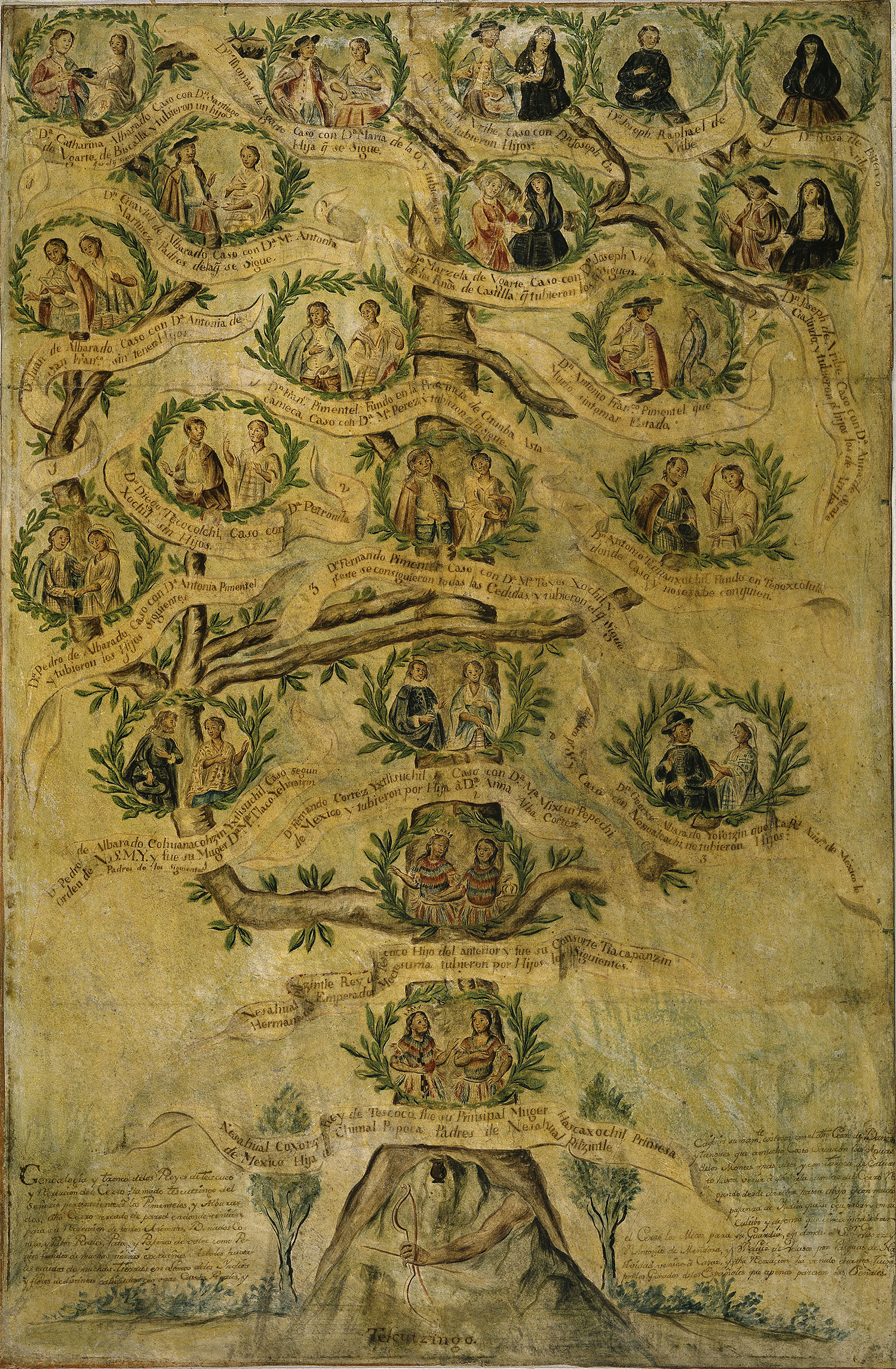Habsburg black fashion was on the way out by the 1650s. By the 1660s the British were mocking everything Spanish, including clothing. By the 1680s, Spanish and British elites adopted French styles. A whole spectrum of French blues, as well as yellows, pinks and other colours, became the rage. By the time the French Bourbons unseated Habsburg rulers in Spain in the early 1700s, the fashion shift was visible throughout Europe and in the Indies as well. In this early 1700s genealogy crafted by an aristocratic Indian family of Tezcoco in central Mexico, ‘gentile’ feathered sovereigns give way to Habsburg vassals in black robes, only to don the lighter and more playful French styles of the Bourbon era. From Mexico to London, playfulness of hue and form had triumphed over sobriety, at least for the time being.
Changing Fashions in a Texcoco Dynasty
An early 1700s genealogy commissioned by a branch of a Tezcoco dynasty in central Mexico, suggesting changing fashions over the centuries. Nr. IV Ca 3011 (courtesy of Ethnologisches Museum, Staatliche Museen zu Berlin; photo by C. Obrocki).
Adrian Masters
Further reading
- Colomer, J.L., and A. Descalso (eds.) (2014) Spanish Fashion at the Courts of Early Modern Europe, vol. 2 (Madrid: CEEH).
- Contreras Sánchez, A. (1990) Historia de una tintórea olvidada: el proceso de explotación y circulación del palo de tinte, 1750–1807 (Mérida: Universidad Autónoma de Yucatán).
- Cooper, M. (1974) Rodrigues the Interpreter: An Early Jesuit in Japan and China (New York, NY: Weatherhill).
- Elliott, J.H. (1990) Imperial Spain, 1469–1716 (London: Penguin Books).
- Harvey, J. (1995) Men in Black (New York, NY: Columbia University Press).
- Jarvis, M.J. (2010) In the Eye of All Trade: Bermuda, Bermudians, and the Maritime Atlantic World, 1680–1783 (Chapel Hill, NC: University of North Carolina Press).
- McDonald, K.P. (2018) ‘“Sailors from the woods:” Logwood cutting and the spectrum of piracy’, in The Golden Age of Piracy: The Rise, Fall,and Enduring Popularity of Pirates, edited by Head, 50–74 (Athens, GA: University of Georgia Press).
- Netherton, R., and G.R. Owen-Crocker (eds.) (2007) Medieval Clothing and Textiles, vol. 3 (Woodbridge, Suffolk: Boydell Press).
- Pastoureau, M. (2008) Black: The History of a Color (Princeton, NJ: Princeton University Press).
- Record, S.J., and R.W. Hess (1943) Timbers of the New World (New Haven, CT: Yale University Press).
- Richmond Ellis, R. (2012) They Need Nothing: Hispanic-Asian Encounters of the Colonial Period (Toronto: University of Toronto Press).
- Roquero, A. (2006) Tintes y tintoreros de América (Madrid: Ministerio de Cultura).
- Tiesler, V., and M.C. Lozada (eds.) (2018) Social Skins of the Head: Body Beliefs and Ritual in Ancient Mesoamerica and the Andes (Albuquerque, NM: University of New Mexico Press).
- Valentini, M.B. (1704) Museum Museorum, oder Vollständige Schau-Bühne aller Materialen und Specereyen (Frankfurt am Main: Verlegung Johann David Zunners).





